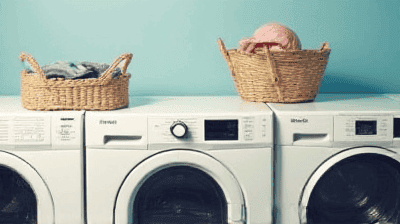5 Laundry Mistakes You're Probably Making and How to Fix Them

Laundry is one of those household chores that seems simple enough, yet many of us make mistakes that can compromise our clothes' longevity, cleanliness, and overall appearance. Whether it’s misunderstanding detergent measurements, ignoring fabric care labels, or neglecting to sort laundry correctly, these common missteps can lead to unwanted results.
Mistake 1: Not Sorting Your Laundry Properly
Why Sorting Matters
One of the most frequent mistakes made during laundry is failing to sort clothes correctly before washing. Sorting is crucial for several reasons:
Color Safety: Washing dark colors with lights can lead to dye transfer, resulting in pink or gray clothing. This is especially problematic with new garments that haven't been washed yet.
Fabric Thickness: Different fabrics require different wash cycles. Heavy materials, such as towels or jeans, may need more agitation and longer cycle times compared to delicate fabrics like silk or lace.
Lint Transfer: Washing lint-producing fabrics (like towels and flannels) with lint-attracting fabrics (like polyester) can leave your polyester clothes covered in lint and make them less presentable.
How to Fix It
1. Implement a Sorting System
Color Categories: Sort your laundry into whites, lights, darks, and delicates. A general rule is to wash whites (like cottons) together, lights (like pastels) together, and darks (like blacks and navy) separately.
Fabric Types: Also consider sorting by fabric type. For instance, keep heavier items like towels separate from lighter or more delicate items. This allows you to select the most appropriate wash cycle and temperature.
Create a Sorting Hamper: To make the sorting process easier, invest in a multi-compartment laundry hamper. Label each section for colors, delicates, and darks, so sorting becomes part of your routine.
2. Check Care Labels
Always read and understand care labels on your garments. This gives you valuable information on how to wash, dry, and iron each item, ultimately preserving the fabric and extending its lifespan.
Mistake 2: Using Too Much Detergent

The Consequences of Overusing Detergent
It can be tempting to use extra detergent to ensure a clean wash, but more isn't always better. Using too much detergent can lead to several issues, including:
Residue Build-Up: Excess detergent can cause residue to build up on clothes and inside your washing machine, leading to unpleasant odors and potential mold growth.
Skin Irritation: Leftover detergent can irritate sensitive skin, particularly in children and individuals with allergies.
Diminished Cleaning Power: Overloaded detergent can leave clothes feeling soapy and less clean, defeating the purpose of your laundry efforts.
How to Fix It
1. Follow the Manufacturer’s Guidelines
Use the Right Amount: Check the packaging of your laundry detergent for the recommended amounts based on your load size—standard and high-efficiency washers may have different requirements.
Measuring Tools: Use the measuring cap or scoop provided with your detergent. If unsure about the amount, start with a smaller amount and adjust as necessary.
2. Consider Load Size
Small Loads: For smaller loads, you don’t need a full measuring cap. Use half of the recommended amount to prevent overuse.
Heavily Soiled Items: If you're washing heavily soiled items, you might need more detergent; however, adding a little extra should suffice rather than doubling your typical amount.
Mistake 3: Washing Everything in Hot Water
The Risks of Hot Water Washing
While hot water can be effective in removing germs and stains, it’s not universally the best choice for every laundry load. Here’s why:
Color Fading: Hot water can lead to color fading on brightly colored fabrics, negatively impacting the appearance and longevity of your clothes.
Shrinkage: Certain fabrics, such as wool and cotton, are susceptible to shrinkage when washed in hot water, which can ruin the fit of your favorite items.
Energy Inefficiency: Heating water consumes more energy, increasing your utility bills and your carbon footprint.
How to Fix It
1. Choose the Right Temperature
Cold Water: Use cold water for delicate fabrics, dark colors, and lightly soiled items. Cold water is gentler on fabrics and helps prevent color bleeding.
Warm Water: This is suitable for synthetic fabrics and general loads that aren’t heavily soiled. It balances effective cleaning without the harshness of hot water.
Hot Water: Reserve hot water washes for whites, bed linens, and heavily soiled items, like towels or work clothes where sanitation is a priority.
2. Be Mindful of Fabric Types
- Always pay attention to the care label, as it provides guidance on the best wash temperature for each garment type. This helps maintain their quality and integrity.
Mistake 4: Neglecting to Check Pockets

The Importance of Emptying Pockets
One simple oversight can cause a cascade of issues—failing to check pockets before washing. Neglecting this step can lead to:
Damage to Clothing: Items like tissues can disintegrate in the wash, creating a mess and leaving lint all over other clothes.
Damage to the Washing Machine: Hard objects such as coins or keys can scratch the drum or cause blockages.
Loss of Items: Valuable items like cash, gift cards, or small personal belongings can be lost in the washing machine or dryer.
How to Fix It
1. Establish a Routine of Pocket Checks
Always check pockets before tossing clothes into the washing machine. This simple habit can save you time and prevent potential damage.
Make it part of your laundry process—perhaps combine it with sorting your clothes. The fewer items left in pockets, the smoother your laundry day.
2. Use Laundry Bags for Small Items
- Consider using mesh laundry bags for delicate items or small accessories. This will keep them together and prevent them from becoming lost in the wash.
Mistake 5: Overloading the Washing Machine
Why Overloading is Problematic
It’s easy to want to get as much laundry done in one go, but cramming the washing machine can lead to several problems:
Ineffective Cleaning: Clothes need space to move around and rub against each other to get clean. Overloading prevents this, resulting in less effective washing.
Increased Wear and Tear: Overloading places unnecessary strain on the washing machine’s components, potentially leading to breakdowns.
Inadequate Rinsing: Too many clothes can also prevent effective rinsing, leaving detergent residue on fabrics, which could lead to irritation or a dingy appearance.
How to Fix It
1. Understand Load Capacity
Every washing machine has a specified capacity. Refer to your machine’s manual to understand its limits, which is usually expressed in pounds.
For instance, a standard top-loading machine typically holds about 12-16 pounds, while front-loading machines can handle more.
2. Learn to Separate Loads
Separate heavy items like towels and bedding from lighter items to maintain effectiveness in cleaning.
If you have too much laundry for one wash, consider splitting larger loads into smaller, manageable batches.
Conclusion

By addressing these five common laundry mistakes—improper sorting, overusing detergent, washing everything in hot water, neglecting to check pockets, and overloading the washing machine—you can significantly enhance the efficiency and effectiveness of your laundry routine. Understanding the reasons behind these mistakes and implementing the suggested fixes will help you preserve your clothes, save time, and reduce frustration.
Making small adjustments will lead to big rewards in terms of cleaner laundry, longer-lasting garments, and a more pleasant laundry experience overall. So the next time you tackle your laundry, remember to avoid these pitfalls and enjoy the satisfaction of fresh, clean clothes without the common laundry woes!


